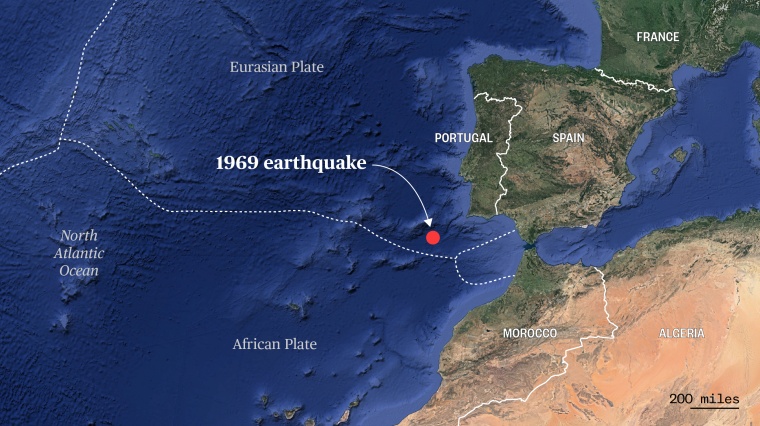Off the coast of Portugal, deep under a featureless and geologically drab stretch of the seafloor, scientists think something dramatic is happening: A tectonic plate is peeling apart, creating a new “subduction zone” that one day could become a hotbed of seismic and volcanic activity.
The unexpected discovery, which was presented at a scientific conference in Vienna in April, may represent the first time scientists have seen a new subduction zone being born. It may also help explain a pair of mysterious earthquakes that hit the region — a massive one that devastated Lisbon in 1755 and a slightly smaller one that struck the same area in 1969.
Until now, researchers had been at a loss to explain what triggered those quakes.
“It’s far away from any known tectonic fault, and it’s a flat area of the seafloor, so this has always been an enigma,” said João Duarte, a marine geologist at the University of Lisbon and the leader of the research that revealed the underground activity.
Download the NBC News app for breaking news
Earth’s crust is made up of a dozen large tectonic plates, irregularly shaped rocky slabs that bump into, climb over or slide beneath one another as they move about slowly but continuously. Earthquakes and volcanic eruptions tend to cluster in subduction zones, which occur along the boundaries between the plates when one is pushed under another.
The Lisbon quake, which struck on Nov. 1, 1755, leveled much of the city, triggered a tsunami and caused as many as 100,000 deaths. Seismometers didn’t exist at the time, but scientists estimate that it was a magnitude 8.5 to 8.7 quake.
More than two centuries later, on Feb. 28, 1969, a magnitude 7.8 earthquake struck the same area.
To understand what could have caused the puzzling quakes, Duarte and his colleagues analyzed seismic data collected in 2007 and 2008 from instruments placed on the seafloor, along with data from a pair of other previous studies — both of which detected a strangely dense region about 150 miles below the epicenter of the 1969 quake.
Duarte said the data suggested that this dense region is evidence that seawater is slowly seeping into the tectonic plate through a series of cracks, weakening its overall structure and causing the bottom of the plate to peel away from the top. The process likely started around 10 million years ago, he said, adding that computer modeling had confirmed the process as a likely possibility.
“I sometimes think of it as an embryonic subduction zone,” Duarte said. “It’s not fully mature yet, but the conditions are all there.”
The idea that the plate is peeling apart isn't new. In 1975, Michael Purdy, a geophysicist now affiliated with Columbia University, drew a sketch showing the same process that Duarte and his team identified. “He had an intuition but didn’t have any data to support it,” Duarte said of Purdy. “It was kind of a wild idea, but the sketch looks very similar to the result of our numerical model. I was really excited about that.”
Chris Goldfinger, an Oregon State University geologist who wasn't involved with the new research, called the proposed explanation of the peeling tectonic plate “very plausible.”
“It still remains the only one that is viable,” he said. “Usually you have multiple hypotheses that you can play off each other, but there really isn’t an alternative at this point."
Goldfinger said more research is needed to confirm the existence of a newly forming subduction zone. “This is still a hypothesis that is mostly supported by a computer model,” he said. “This is all happening deep enough in the Earth that seeing it, at least with present technology, is not possible.”
Want more stories about science?
- The moon is shrinking, and a new study shows it's racked by moonquakes
- Explorer reaches bottom of Mariana Trench, sets record for deepest dive
- Carbon dioxide hits a level not seen for 3 million years. Here's what that means for climate change — and humanity.
SIGN UP FOR THE MACH NEWSLETTER AND FOLLOW NBC NEWS MACH ON TWITTER, FACEBOOK, AND INSTAGRAM.


